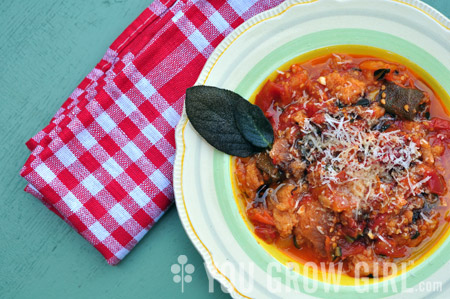
These last days of the tomato harvest are fast approaching and I am finding myself increasingly careful about how I use up the remaining fresh fruit. This is it and then I am back to another 8-9 month wait before I get to taste the good stuff fresh again.
It was with this late season panic infecting my brain that I decided I’d better get on enjoying a few last-minute tomato soups. My go-to, there-is-no-other-way-to-enjoy-it-thanyouverymuch method is roasted in the oven. Always with basil. I’ve probably thrown in some oregano now and again. Thyme is also a possible addition. But for the most part I am wholly dedicated to basil in my tomato soup.
I would never dream of marring the perfection of my tomato soup with another herb, certainly not a strong one like fresh sage. Never say never. The other day I was flipping through, “My favorite ingredients,” a cookbook by Skye Gyngell and stopped on a tomato bread soup recipe that used sage as its primary herbal flavour. I’ve made tomato bread soup in the past and while I don’t mind bread soups in general when the ingredients are good and the bread is appropriately dense, I’m always a little taken aback by the mushiness, a textural aversion that I have held onto from my childhood when our cheap canned soup lunches were bulked up by soggy crackers. That said, it wasn’t this aspect of the soup that caused me to pay attention, but the sage.
Sage in tomato soup you say?
I dared myself to try something different and potentially waste one of my last gluts of good homegrown tomatoes. I didn’t follow the recipe exactly. I used more tomatoes than were called for; I didn’t bother measuring out any of the ingredients, come to think of it. Her recipe includes a hot, dried chile pepper, but I decided to use the fresh, mildly hot peppers that are still coming from my garden. I topped mine with grated pecorino cheese. I did not use the chewy, peasant style bread that is often called for in bread soups because I didn’t have any. Instead, I opted for a few slices of stale spelt bread that I had in the fridge. Again though, it was the use of strong, earthy sage versus basil in a tomato soup that I was most interested in. The only reason why I stayed with the bread soup version was because I wanted to stretch this out into a meal.
I was not disappointed. We ate up the whole pot! This would make a particularly warming late fall/winter meal by substituting fresh tomatoes for a jar that has been home-canned (or purchased).
Recipe: Tomato and Sage Bread Soup
This is a simple recipe that really doesn’t require accuracy. Like I said, I guessed at amounts and went with what looked right proportionately. That’s how I make all of my soups, by eyeballing it. The only thing I’d advise is to go light on the sage. Fresh sage is strong; too much is overkill.
Roughly chop about 2-3 lbs of whole, fresh, heirloom tomatoes. Do not discard the peel or seeds. Heat up a couple of tablespoons of olive oil and add the chopped tomatoes along with a few cloves of finely chopped garlic and one finely chopped pepper (hot or sweet). Substitute with pepper flakes if you prefer the heat. That’s the traditional way to go. Stir in 8 whole sage leaves. I used large leaf, German sage so I put in less. Cook on a low heat for 30-40 minutes.
When the tomatoes are cooked, add salt to taste. Roughly tear up 2-3 slices of stale bread and add to the soup. You can always toast the slices if the bread is not stale.
Serve warm with a splash of olive oil. A drizzle of Balsamic vinegar and a sprinkle of grated pecorino or Parmesan cheese are optional. Garnish with fried sage leaves. To make: fry fresh, whole sage leaves in butter or olive oil until brown. If you eat meat, you can also add some fried prosciutto bits.
Sounds daring…. I have this big sage in my garden that I’m always scared to use especially wth tomatoes, in case it overpowers everything…. I’ll definitely try this recipe over the weekend.
Thanks for pushing the sage-tomato association!
stef